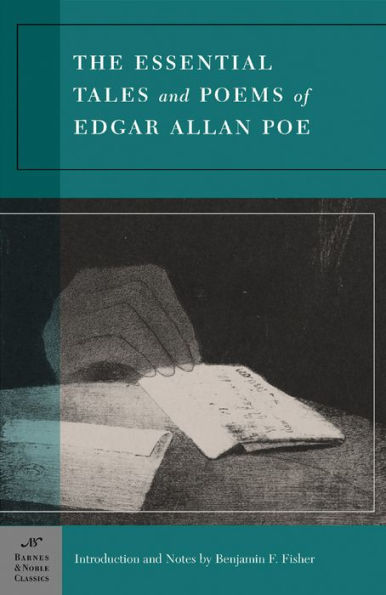Read an Excerpt
From Benjamin F. Fisher’s Introduction to Essential Tales and Poems by Edgar Allan Poe
Poe’s tales continue to be the most admired part of his literary legacy, however much he wished to be a poet. One may legitimately ask what were his reasons for resorting to prose fiction as a mainstay, most notably to the short story or, as he preferred, the "tale"? The answer is simple: money. Poe received no profits from his early poems, so he turned to a form that was likely to sell better, the short story, and specifically to short fiction in the Gothic vein. Tales featuring a single character (or at least one who stood out from any others), beset by oppressive and mysterious forces, often amid fantastic settings, existed long before Poe found in this paradigm a suitable creative medium. Terror tales had become staples in periodicals, chiefly in a renowned literary magazine in the Anglo-American literary world during the 1820s, 1830s, and 1840s, the house organ for the well-established Scottish publishing firm of Blackwood: Blackwood’s Edinburgh Magazine, colloquially called Blackwood’s or Blackwood. It is evident from his writings that Poe’s knowledge of this periodical was extensive. His satiric tale "How to Write a Blackwood Article" and its sequel, "A Predicament," lampoon not just recurrent themes, motifs, and stylistic techniques of stories from Blackwood’s, but indeed ridicule Poe’s own hallmark methods and themes in fiction. Compelling satire and parody require expert comprehension of what one wishes to treat comically, and so we might examine Poe’s own fiction to discover what he understood of the production of intriguing Gothic tales.
Apparently, from the time he left West Point in 1831 for his grandmother Poe’s home in Baltimore, until his name appeared in connection with a literary contest in that city late in 1833, he thoughtfully considered what should constitute effective tales of terror. He gave himself an independent study course in content and methodology in popular Gothic fiction as groundwork for his own. He submitted five tales to a prize contest sponsored by a Philadelphia newspaper, the Saturday Courier, near the end of 1831. Although none won the prize, they all circulated in the paper, perhaps without Poe’s consent or knowledge, during 1832. The first to appear, "Metzengerstein," seems all too customarily horrific in its "German" setting and its feuding families, connected by supernatural occurrences, who suffer stupendous catastrophes. Horror is evident in young Frederick Metzengerstein’s lips, lacerated in fright during his sensational final journey mounted on a giant supernatural horse, an ominous, repulsive creature. This tale may devolve from the folk motif of the devil riding a giant black horse to claim his victims. Poe alters the traditional black coloring of the horse to fiery shades. The other Courier tales were spoofs on what were then best-selling fictions and their authors, and one was not even Gothic.
In 1833 the Baltimore Saturday Visiter, a weekly newspaper, sponsored a competition with cash prizes for the best poem and tale. Poe’s tale "MS. Found in a Bottle" and his poem "The Coliseum" were ranked the winners until the evaluators discovered that both were written by the same person. They decided that the poetry prize would go elsewhere, although Poe asked that they give the other writer the money for the poem but announce that both of his own works had originally been named first’s. Poe’s wish was ignored, the poetry prize going to "Song of the Winds," by John Hill Hewitt, editor of the Visiter, leaving Poe outraged. The prize selections appeared on October 19, 1833, and Poe’s poem on October 26. Those publications, which were reprinted elsewhere in the United States, brought the young writer his first literary recognition.
Looming, too, was another experimental venture of Poe’s, generally known as "Tales of the Folio Club," a book of interlocking frame narratives.4 In this scheme, never actualized, a group of writers, the Folio Club, meet monthly for literary reading and critiques. Preceding the readings are substantial suppers accompanied by plenty of alcohol. After each member reads his original "brief prose tale" (a hit at some best-selling author’s typical theme and form), critiques follow. Poe once wrote that these critical interchanges were meant to enliven comedy in the project: Voiced by pretentious would-be authors, each tale is delivered by a first-person narrator, a caricature of an actual popular author represented. Because the author-reader of the worst tale hosts the next meeting, and because one of the group has his works successively targeted, in Poe’s scheme, someone in the group eventually becomes enraged, flees to a publisher with the manuscripts, and hurries them into print as an exposé, for revenge.
What doubtless enlivened the overall scheme was that the club members, from the effects of either eating or/and drinking too much, would have articulated corresponding bizarre situations and repetitious language patterns within their tales, imparting zesty humor to those fictions, such mirth given point by the critiques. Had "Tales of the Folio Club" been published, a far different conception of Poe might have emerged early in his career—with what future we may only conjecture. Publishers rejected his manuscript, however, on grounds that the content was far too sophisticated for average readers and sales would not warrant the financial risk. Poe eventually dismantled the collection, brought out individual stories in periodicals, and thereby paved the way for readers’ disagreements that continue to be dynamic even today.





